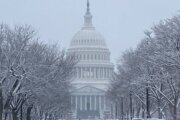Slightly more Americans filed for unemployment benefits last week, but the number of claims remains at healthy levels.
Jobless claims rose by 4,000 to 232,000 for the week of Aug. 17, the Labor Department reported Thursday. The four-week average of claims, which evens out some of the weekly gyrations, ticked down by 750 to 236,000.
For the week ending Aug. 10, 1.86 million Americans were collecting jobless benefits, 4,000 more than the week before.
Weekly filings for unemployment benefits, which are a proxy for layoffs, remain low by historic standards.
From January through May, claims averaged a paltry 213,000 a week. But they started rising in May, hitting 250,000 in late July and adding to evidence that high interest rates are taking a toll on the U.S. job market.
However, the tiny increase in claims this week follows two straight weeks of declines, largely dispelling worries that the job market is deteriorating rapidly rather than just slowing.
The Federal Reserve, fighting inflation that hit a four-decade just over two years ago, raised its benchmark interest rate 11 times in 2022 and 2023, taking it to a 23-year high. Inflation has come down steadily — from more than 9% in June 2022 to a three-year low of 2.9% last month. Despite higher borrowing costs, the economy and hiring kept chugging along, defying widespread fears that the U.S. was poised to tip into a recession.
The economy is weighing heavily on voters as they prepare for November’s presidential election. Despite a solid job market and decelerating inflation, Americans are still exasperated that consumer prices are 19% higher than they were before inflation started to take off in 2021. Many blame President Joe Biden, though it’s unclear whether they will hold Vice President Kamala Harris responsible as she seeks the presidency.
Lately, higher rates have finally seemed to be taking a toll. Employers added just 114,000 jobs in July, well below the January-June monthly average of nearly 218,000. The unemployment rate rose for the fourth straight month in July, though it remains low at 4.3%.
Earlier this week, the Labor Department reported that the U.S. economy added 818,000 fewer jobs from April 2023 through March this year than were originally reported. The revised total supports evidence that the job market has been steadily slowing and likely reinforces the Federal Reserve’s plan to start cutting interest rates soon.
The Labor Department estimated that job growth averaged 174,000 a month in the year that ended in March — a decline of 68,000 a month from the 242,000 that were initially reported. The revisions released Wednesday were preliminary, with final numbers to be issued in February next year.
On top of that, monthly job openings have fallen steadily since peaking at a record 12.2 million in March 2022. They were down to 8.2 million in June.
As signs of an economic slowdown accumulate and inflation continues to drift down toward its 2% target, the Fed is expected to start cutting rates at its next meeting in September.
Copyright © 2025 The Associated Press. All rights reserved. This material may not be published, broadcast, written or redistributed.







